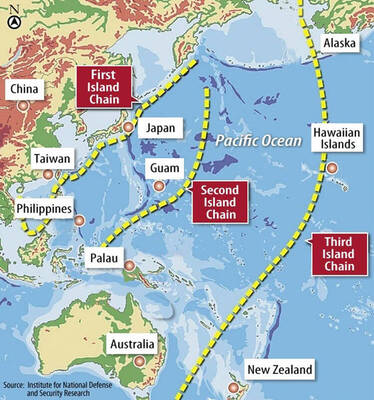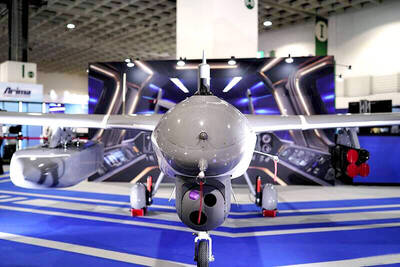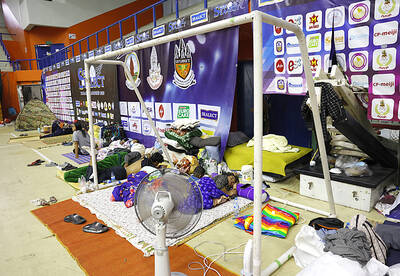Spy satellites have spotted signs that North Korea may be preparing to transport another long-range missile to a test launch site, South Korean officials said yesterday, as the US secretary of defense issued his harshest warning to the North since its recent nuclear test.
“We will not stand idly by as North Korea builds the capability to wreak destruction on any target in Asia — or on us,” US Secretary of Defense Robert Gates told a regional defense meeting in Singapore.
He said North Korea’s nuclear program was a “harbinger of a dark future,” but wasn’t yet a direct threat.
Since last Monday’s nuclear blast, North Korea has test-launched six short-range missiles in a show of force and announced it won’t honor the 1953 truce that ended the fighting in the Korean War.
Now, the reclusive communist state appears to be preparing to move a long-range missile by train from a weapons factory near Pyongyang to its northeastern Musudan-ni launch pad, a South Korean defense ministry official said.
Images of the movements were captured by US satellites, said the official, who was not allowed to be identified when discussing intelligence matters.
The threat of a long-range missile test comes amid heightened tensions over North Korea’s nuclear program.
North Korea, believed to have enough weaponized plutonium for at least six nuclear bombs, walked away from international disarmament negotiations last month in anger over UN criticism of a rocket launch Washington and others called a cover for the test of long-range missile technology.
Experts say Pyongyang is working toward mounting a nuclear bomb on a long-range missile, one capable of reaching the US.
Gates and the defense ministers of Japan and South Korea said North Korea must not be allowed to continue playing a dangerous game of brinksmanship in hopes of winning aid.
“We must make North Korea clearly recognize that it will not be rewarded for its wrong behaviors,” South Korea Defense Minister Lee Sang-hee said.
Officials in Washington said they noticed increased activity at the test site. They spoke on condition of anonymity on Friday, saying methods of gathering information about North Korea were sensitive.
Yonhap said the size of the missile was similar to a long-range rocket the North tested last month.
Experts have said the new three-stage rocket has a potential range of more than 6,700km, putting Alaska within its striking distance.
The North is likely to fire the missile shortly after the UN Security Council adopts a resolution criticizing its recent nuclear test, said Yang Moo-jin, a professor at Seoul’s University of North Korean Studies.
The resolution is expected to call on all countries to immediately enforce sanctions imposed by an earlier UN resolution after Pyongyang’s first nuclear test in 2006.
The sanctions include a partial arms embargo, a ban on luxury goods and ship searches for illegal weapons or material. They have been sporadically implemented, with many of the 192 UN member states ignoring them.
The draft would also have the Security Council condemn “in the strongest terms” the recent nuclear test “in flagrant violation and disregard” of the 2006 resolution.

The US government has signed defense cooperation agreements with Japan and the Philippines to boost the deterrence capabilities of countries in the first island chain, a report by the National Security Bureau (NSB) showed. The main countries on the first island chain include the two nations and Taiwan. The bureau is to present the report at a meeting of the legislature’s Foreign Affairs and National Defense Committee tomorrow. The US military has deployed Typhon missile systems to Japan’s Yamaguchi Prefecture and Zambales province in the Philippines during their joint military exercises. It has also installed NMESIS anti-ship systems in Japan’s Okinawa

‘WIN-WIN’: The Philippines, and central and eastern European countries are important potential drone cooperation partners, Minister of Foreign Affairs Lin Chia-lung said Minister of Foreign Affairs Lin Chia-lung (林佳龍) in an interview published yesterday confirmed that there are joint ventures between Taiwan and Poland in the drone industry. Lin made the remark in an exclusive interview with the Chinese-language Liberty Times (the Taipei Times’ sister paper). The government-backed Taiwan Excellence Drone International Business Opportunities Alliance and the Polish Chamber of Unmanned Systems on Wednesday last week signed a memorandum of understanding in Poland to develop a “non-China” supply chain for drones and work together on key technologies. Asked if Taiwan prioritized Poland among central and eastern European countries in drone collaboration, Lin

Renewed border fighting between Thailand and Cambodia showed no signs of abating yesterday, leaving hundreds of thousands of displaced people in both countries living in strained conditions as more flooded into temporary shelters. Reporters on the Thai side of the border heard sounds of outgoing, indirect fire yesterday. About 400,000 people have been evacuated from affected areas in Thailand and about 700 schools closed while fighting was ongoing in four border provinces, said Thai Rear Admiral Surasant Kongsiri, a spokesman for the military. Cambodia evacuated more than 127,000 villagers and closed hundreds of schools, the Thai Ministry of Defense said. Thailand’s military announced that

CABINET APPROVAL: People seeking assisted reproduction must be assessed to determine whether they would be adequate parents, the planned changes say Proposed amendments to the Assisted Reproduction Act (人工生殖法) advanced yesterday by the Executive Yuan would grant married lesbian couples and single women access to legal assisted reproductive services. The proposed revisions are “based on the fundamental principle of respecting women’s reproductive autonomy,” Cabinet spokesperson Michelle Lee (李慧芝) quoted Vice Premier Cheng Li-chiun (鄭麗君), who presided over a Cabinet meeting earlier yesterday, as saying at the briefing. The draft amendment would be submitted to the legislature for review. The Ministry of Health and Welfare, which proposed the amendments, said that experts on children’s rights, gender equality, law and medicine attended cross-disciplinary meetings, adding that